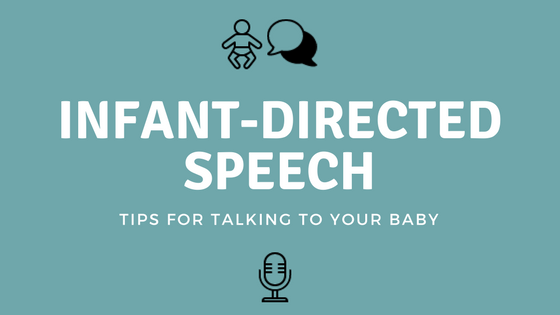Ever wondered why you change your voice when you talk to babies?

In this episode, Ayelet discusses this phenomenon (known as “infant-directed speech,” “motherese,” or “parentese”).
She covers tips on ways to communicate with babies, the innate reasons we modify our voices when we talk to babies, and the research that supports those changes!
Below is the transcript of this week’s “Developmental Thought,” an excerpt from the full episode. For additional information, music, play ideas and the complete interactive family experience, please listen to the entire episode.
So, what does the research say – why do we use infant-directed speech? If we all do it, in practically every language, it must serve some function, right? Researchers believe that there are many reasons for this.
>>Don’t Miss Our Corresponding Blog Post!<<
Great resources we mentioned in this podcast episode (in order they were mentioned):
Why do we sing to young children?
The Top 10 Musicians Every Family Should Know
Cognitive Development in Infants & Toddlers
Motherese in Interaction: At the Cross-Road of Emotion and Cognition
Connect With Us:
Ayelet: Facebook / Instagram / Pinterest
Attention and and Distinction
It is likely that infant-directed speech helps infants to determine a caregiver’s intentions – the “prosody” or the natural melody of speech (inflection, intonation) is something that infants pay attention to, and pay attention to for a longer period of time than typical adult speech patterns, suggesting that infant-directed speech actually aids in their cognitive development.
In other words, infants are focusing in on the parts of our communication that add to our meaning – things like the way we use melody in our speech patterns – so when we use slightly exaggerated intonations or repeat the last part of our sentence, for instance, “here’s what we’re going to do next… we take off your shirt so we can put a clean one on! Yes, we need to put a cleaaan one on!” – we are allowing them to infer meaning and we are also making it more interesting to them because they hear patterns.
Even though the content of our communication may vary each time, we might actually use the same inflections without knowing we’re doing it, each time we perform a dressing and undressing routine with our little one.
Preference and Responsiveness
Research has actually shown that infants prefer to listen to infant-directed speech when compared to what we can refer to as “adult-directed speech,” or, normal speech patterns in adults.
They’re also more responsive – they look longer and focus more (again, this is shown also with deaf infants who are seeing infant-directed signing!
Even when infants are sleeping, their brains respond more to hearing infant-directed speech (than to typical adult speech patterns).
Elements of Speech and Language
Research also suggests that Infant-directed speech helps infants piece apart syllables and discriminate between syllables as well as categorize different vowels in their native language.
In addition, it may help them to recognize when one word ends and another begins, as well as recognize words, helping them to process speech and language.
They’re Paying Attention!
So, we see that the use of infant-directed speech likely has an effect on almost all major areas of development, including social/emotional, cognitive, and communicative development. Now, again, I’m not saying that you have to be gushy-gushy with your little one to stimulate his brain.
But when you speak to your infant or young toddler, and you sing to your infant or toddler, remember that when you repeat what you say, when you ask them a question (even when they can’t answer), when you point at something and look back at your little one, when you speak a bit more slowly or with slightly more inflection than you would with another adult, you don’t sound ridiculous to them – in fact, you sound more interesting!
References:
Fernald, A. (1992). Human Maternal vocalizations to infants as biologically relevant signals: An evolutionary perspective. In J. H. Barkow & L. Cosmides (Eds.), The adapted mind: Evolutionary psychology and the generation of culture (pp. 391-428). London: Oxford University Press.
Saint-Georges, C., Chetouani, M., Cassel, R., Apicella, F., Mahdhaoui, A., Muratori, F., … Cohen, D. (2013). Motherese in Interaction: At the Cross-Road of Emotion and Cognition (A Systematic Review). PLoS ONE, 8(10), e78103. http://doi.org/10.1371/journal.pone.0078103https://www.ncbi.nlm.nih.gov/pmc/articles/PMC3800080/pdf/pone.0078103.pdf

